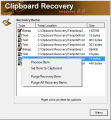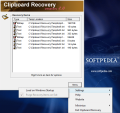Windows Clipboard is the temporary closet for storing different items (from text clippings to entire files and even folders) for short periods, generally for moving or copying them from one location to another. But sometimes you might need more than one item in the scratch pad and here's where the function in Windows fails to give you a hand.
It can even get frustrating enough to catalyze a search for a better tool that can remember more than one item in the clipboard. In this sense, there are various instruments of different shapes, sizes and prices on the market, ready to assist you. Clipboard Recovery comes as a free solution for the above-mentioned problem, with an interface that cannot possibly pose problems regardless of the computer skills of the user.
From installation until it comes to actually using the application, Clipboard Recovery is a smooth ride. It works on both Vista and XP with the same success and there is absolutely no complicated setting for you to bump into. To tell you the truth, there couldn't be a simpler application, although all its simplicity has a high impact on its functionality.
Main application window is straight forward providing a list with items that passed through Windows clipboard at one moment or another. You may notice from the image below that there are only texts and bitmaps available because these are the only formats supported by the application. This limitation represents one major disadvantage of the application, as support for almost any type of file would be greatly appreciated.
Immediately after installation, the application will create a temporary folder on system drive, where all clips will be saved. Exiting the program will empty the folder automatically, as these can take a lot of space if clipboard is under intensive use.
All items in Clipboard Recovery will be displayed the type (text or bitmap), the location of the temporary storage location and the size it takes on disk. The only options available at right clicking one of the listed items refer to previewing the item (it will be opened in the associated program), place it back in Windows Clipboard, purge it from the list, or purge all of them.
The menu available in the lower right hand corner is not any richer in options, actually it is poorer. It contains the settings area that allows only configuring the application to run on Windows startup. The other option available is for automatic purging of items upon exiting the program. This is for preventing too many recovered clipboard items to gather in application's temporary folder.
Additional options on the Menu include minimizing Clipboard Recovery either to system tray (thus becoming much less intrusive) or to taskbar. There is no other way to get rid of the app's main application window (right clicking on the taskbar window shows absolutely no option) but using these two options, and this makes the user invest considerable effort, as compared to the simple action. A much better idea would have been to "plant" the buttons directly into the interface.
Although Clipboard Recovery could be extremely useful in some cases, there are many aspects that have been overlooked by the developer and working with it can become really frustrating, as there are plenty of operations to make in order to achieve the simplest result. Minimizing it to system tray or taskbar requires navigation through a pretty shallow menu whose options could have been integrated completely in the interface, making them quicker to reach.
Finding the desired piece of text can take a while if the list of items is large enough, because there is absolutely no hint on the content of each item. In application window all is stated are the type of the file (bitmap or text), the location and size. Their names are generic and the only difference is the numbers representing the order the files were saved in.
Clipboard Recovery indeed retains all text and bitmaps passing through Windows Clipboard, giving the possibility of printscreening as often as you want without losing any of the pictures. It can also sit minimized to system tray recording all clipboard copied text with absolutely no problem.
The Good
The application saves all copied text and bitmap images to a temporary file on the disk, allowing you to recover them later. It can sit in system tray and retain all the data without bothering the user.
All clipboard text and bitmap images are saved to disk and you can open them up from the temporary folder at any time.
When exiting the application, it will automatically purge all saved items, thus giving back all space on the disk without any effort from the user. You can preview any of the saved items directly from the software, as it opens them in the associated program.
The Bad
Clipboard Recovery is quite difficult to manage when it comes to simple operations, like minimizing it to system tray or even to taskbar, as there are no direct buttons for these actions.
There is no internal possibility of viewing the content of each saved item directly from the application, saving by means of previewing it, which is actually opening in the associated program.
There is no way to make a difference between saved clipboard files in application's temporary folder. The location of this folder cannot be changed.
Using a saved item requires setting it to clipboard, which translates in saving the same text all over again and having double entries in the list.
The Truth
Clipboard Recovery does its job at saving all text and bitmap images going through Windows Clipboard, but users may find it pretty difficult to work with. There is a lot to improve regarding flexibility (only bitmap images are supported) and ease of use (minimizing to either system tray or taskbar requires accessing program's menu). In addition, making available an internal window for previewing the text the moment it is selected would be a great enhancement.
Here are some snapshots of the application in action:
 14 DAY TRIAL //
14 DAY TRIAL // 

